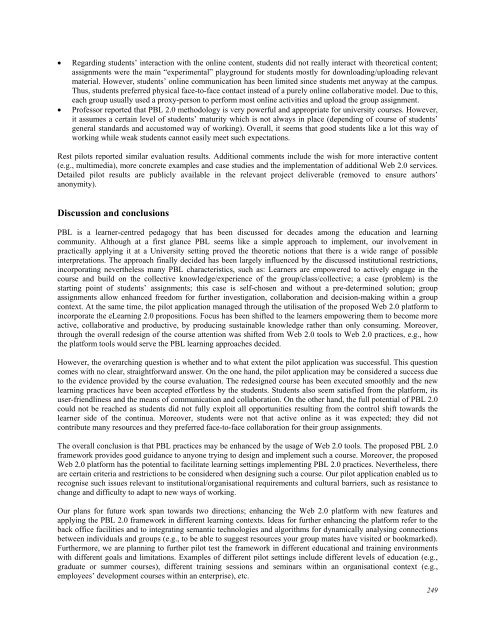October 2012 Volume 15 Number 4 - Educational Technology ...
October 2012 Volume 15 Number 4 - Educational Technology ...
October 2012 Volume 15 Number 4 - Educational Technology ...
Create successful ePaper yourself
Turn your PDF publications into a flip-book with our unique Google optimized e-Paper software.
Regarding students’ interaction with the online content, students did not really interact with theoretical content;<br />
assignments were the main “experimental” playground for students mostly for downloading/uploading relevant<br />
material. However, students’ online communication has been limited since students met anyway at the campus.<br />
Thus, students preferred physical face-to-face contact instead of a purely online collaborative model. Due to this,<br />
each group usually used a proxy-person to perform most online activities and upload the group assignment.<br />
Professor reported that PBL 2.0 methodology is very powerful and appropriate for university courses. However,<br />
it assumes a certain level of students’ maturity which is not always in place (depending of course of students’<br />
general standards and accustomed way of working). Overall, it seems that good students like a lot this way of<br />
working while weak students cannot easily meet such expectations.<br />
Rest pilots reported similar evaluation results. Additional comments include the wish for more interactive content<br />
(e.g., multimedia), more concrete examples and case studies and the implementation of additional Web 2.0 services.<br />
Detailed pilot results are publicly available in the relevant project deliverable (removed to ensure authors’<br />
anonymity).<br />
Discussion and conclusions<br />
PBL is a learner-centred pedagogy that has been discussed for decades among the education and learning<br />
community. Although at a first glance PBL seems like a simple approach to implement, our involvement in<br />
practically applying it at a University setting proved the theoretic notions that there is a wide range of possible<br />
interpretations. The approach finally decided has been largely influenced by the discussed institutional restrictions,<br />
incorporating nevertheless many PBL characteristics, such as: Learners are empowered to actively engage in the<br />
course and build on the collective knowledge/experience of the group/class/collective; a case (problem) is the<br />
starting point of students’ assignments; this case is self-chosen and without a pre-determined solution; group<br />
assignments allow enhanced freedom for further investigation, collaboration and decision-making within a group<br />
context. At the same time, the pilot application managed through the utilisation of the proposed Web 2.0 platform to<br />
incorporate the eLearning 2.0 propositions. Focus has been shifted to the learners empowering them to become more<br />
active, collaborative and productive, by producing sustainable knowledge rather than only consuming. Moreover,<br />
through the overall redesign of the course attention was shifted from Web 2.0 tools to Web 2.0 practices, e.g., how<br />
the platform tools would serve the PBL learning approaches decided.<br />
However, the overarching question is whether and to what extent the pilot application was successful. This question<br />
comes with no clear, straightforward answer. On the one hand, the pilot application may be considered a success due<br />
to the evidence provided by the course evaluation. The redesigned course has been executed smoothly and the new<br />
learning practices have been accepted effortless by the students. Students also seem satisfied from the platform, its<br />
user-friendliness and the means of communication and collaboration. On the other hand, the full potential of PBL 2.0<br />
could not be reached as students did not fully exploit all opportunities resulting from the control shift towards the<br />
learner side of the continua. Moreover, students were not that active online as it was expected; they did not<br />
contribute many resources and they preferred face-to-face collaboration for their group assignments.<br />
The overall conclusion is that PBL practices may be enhanced by the usage of Web 2.0 tools. The proposed PBL 2.0<br />
framework provides good guidance to anyone trying to design and implement such a course. Moreover, the proposed<br />
Web 2.0 platform has the potential to facilitate learning settings implementing PBL 2.0 practices. Nevertheless, there<br />
are certain criteria and restrictions to be considered when designing such a course. Our pilot application enabled us to<br />
recognise such issues relevant to institutional/organisational requirements and cultural barriers, such as resistance to<br />
change and difficulty to adapt to new ways of working.<br />
Our plans for future work span towards two directions; enhancing the Web 2.0 platform with new features and<br />
applying the PBL 2.0 framework in different learning contexts. Ideas for further enhancing the platform refer to the<br />
back office facilities and to integrating semantic technologies and algorithms for dynamically analysing connections<br />
between individuals and groups (e.g., to be able to suggest resources your group mates have visited or bookmarked).<br />
Furthermore, we are planning to further pilot test the framework in different educational and training environments<br />
with different goals and limitations. Examples of different pilot settings include different levels of education (e.g.,<br />
graduate or summer courses), different training sessions and seminars within an organisational context (e.g.,<br />
employees’ development courses within an enterprise), etc.<br />
249

















